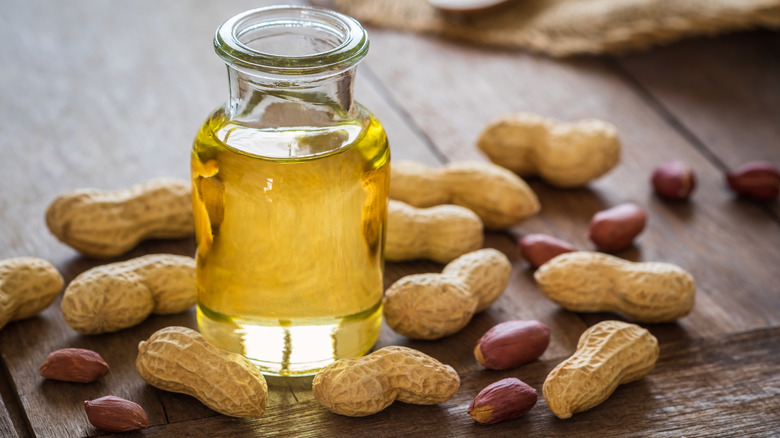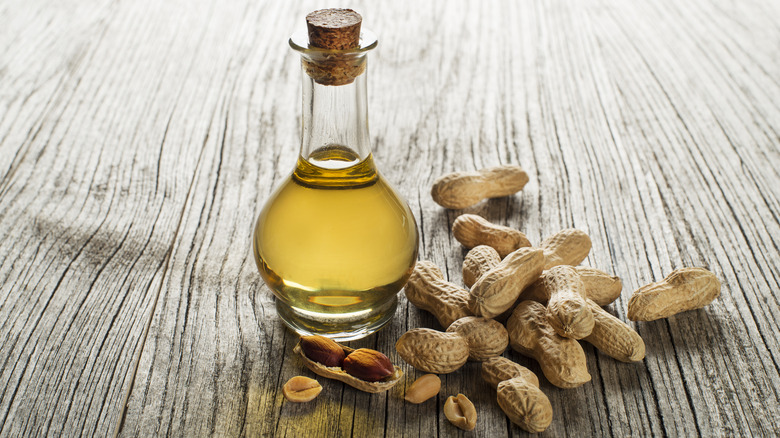What Is Green Peanut Oil And How Is It Used?
Oils have been used in various ways and produced by different seeds and animal fats for centuries, but it wasn't until the early 19th century in France that peanut oil was first invented, according to CooksInfo. While it was used largely in soap making, it has since become a staple in many home kitchens and restaurants for high heat cooking, like deep frying.
While many people are familiar with the cooking versatility and neutral taste of peanut oil, they may not know about the unique, luxurious green peanut oil. This oil was praised in a 2016 New York Times article after winning various awards for its unique, potent peanut taste and manufacturing process, per Oliver Farm. It's made in Pitts, Georgia, far from its French origins. While the oil has received a great deal of attention, many may not be familiar with exactly what it is, how it's made, or how to cook with it.
What is green peanut oil?
Green peanut oil isn't made from a special variety or species of peanut. As Zingerman's explains, the secret behind the name is that the peanuts are raw when they're pressed for oil. Regular peanut oil requires the peanuts to be dried before being cold pressed or refined using chemicals, per Healthline.
Compared to even higher-end peanut oils, green peanut oil is incredibly pure. Clay Oliver, one of the major producers of the oil, explained to Zingerman's that the raw peanut seeds are crushed and then the debris is cleaned out, leaving behind just the oil — not chemically refined, heated, or treated in any kind of way, similar to extra virgin olive oil. This process leaves behind a very strong peanut flavor not found in your average bottle of peanut oil, and is similar in effect to other nut oils, like hazelnut and even pumpkin seed oil.
How is green peanut oil made?
The thing that makes green peanut oil unique from regular peanut oil is the way it's produced. As mentioned, the peanuts are raw when they're pressed, per Zingerman's. Regular peanut oil, on the other hand, goes through a process of crushing, softening the nut, flaking, and then roasting it to 120 or 130 degrees Celsius (or roughly 250 to 265 degrees Fahrenheit) which draws out the moisture (via Oil Expeller). These flakes are compressed to squeeze the oil out. This method is called hot pressing, and is common in most mass produced peanut oils.
Green peanut oil, however, is cold pressed. Cold pressing takes longer, and is all done below 60 degrees Celsius, or 140 degrees Fahrenheit. The nuts are raw and aren't dried beforehand, so all the oil expelled from the crushing process is 100% pure peanut flavor, which separates it from even higher-grade regular peanut oils. Green peanut oil also doesn't use any chemicals to filter or refine it. Instead, producers just strain out the debris. Green peanut oil is mostly exclusive to the brand Oliver Farm, who invented the process of pressing the raw peanuts into the flavorful cooking oil. The oil ranges in price from $3 to $26, and ranges in size from a two-ounce sampler bottle to a one-gallon jug.
What does green peanut oil taste like?
Green peanut oil has gained a lot of popularity for its stark, potent peanut taste. While peanut oil itself is usually used as a neutral frying oil, green peanut oil has a very strong, distinctive flavor. Despite its nuttiness, it's also described as being quite fresh. According to Milk Street Store's description, it's rich and lush, but light enough in flavor to be used in place of olive oil — especially in dishes that already have nuts in them.
The oil does have a high smoke point at 400 degrees Fahrenheit, per Oliver Farm. That being said, it isn't recommended to use green peanut oil for frying — not primarily, at least. While peanut oil is a good neutral oil for frying, and doesn't dispel much flavor into foods it's cooked in, green peanut oil is heralded for its effective flavor and aromatic qualities. High heats, like those needed for deep frying, can easily break down the oil's flavorful elements.
How to cook with green peanut oil
With its flavorful taste profile and high smoke point, you can get pretty creative with your uses for green peanut oil. Milk Street Store recommends using it in ways that show off its aromatic notes, and avoiding exceptionally high heat that would strip it of those qualities. They recommend using it as a slightly more flavorful alternative to extra virgin olive oil, especially in dishes like pesto or stir fried dishes. They also recommend pairing it with tofu and fish for a nutty boost.
Other ways you can use green peanut oil include in lentil-based hummus, bright vinaigrette dressings, or even in sweeter dishes, like chocolate muffins in place of vegetable oil, according to the National Peanut Board. Anything you add it to will get a strong peanut flavor infused into it, which is starkly different than average refined peanut oil. So start small, using it in a sparing amount for a bright finish and nutty aroma to your favorite dishes.
Nutritional information about green peanut oil
There are varying opinions about how healthy regular peanut oil is. It has a high amount of vitamin E, which can help those with insulin sensitivity slow the rate at which sugars absorb into the bloodstream and digestive system, per Healthline. However, it is also high in omega-6 fatty acids, which are linked to increased inflammation and other health issues.
People are also wary of peanut oil in lower-grade forms because it's usually refined with chemicals. In this regard, green peanut oil can claim to be slightly healthier, as it's just cold pressed peanuts. However, according to Oliver Farm, it is higher in saturated fat than regular peanut oil. While this is good for cooking, it may not be great for your health — saturated fats are linked to increased cholesterol and risk for heart disease (via Mayo Clinic). In total, a one-tablespoon serving of green peanut oil has 14 grams of fat, 128 calories, and about 4% of the recommended daily intake of vitamin E. It isn't necessarily a healthier type of peanut oil, but a purer form.





